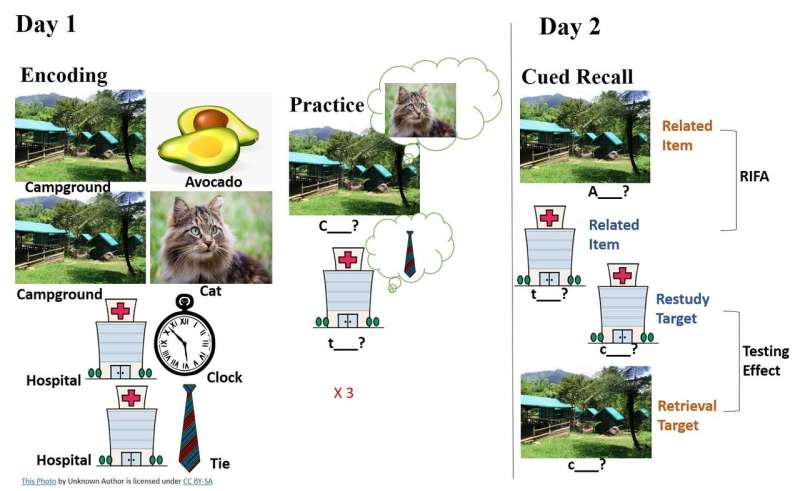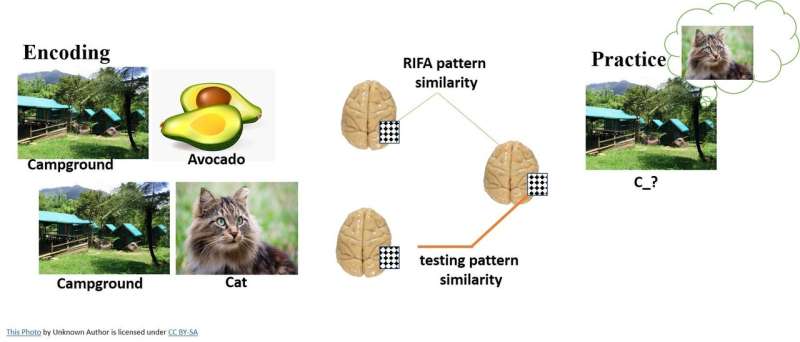October 25, 2018 feature
Recalling memories in context

Information recall goes beyond memory access to powerfully allow long-term memory enhancement. Using human brain imaging, researchers in the UK and US have observed that an attempt to remember a specific event, accompanied the re-activation of additional information from the same event. In a recent study conducted by Tanya R. Jonker and co-workers at the Department of Psychology, memories of the past were shown to be organized as integrated events. The study showed that even the act of recalling a minor aspect of an event will engage brain networks with powerful effects, to retain information from the entire event. The outcomes of the study were published in the Proceedings of the National Academy of Sciences (PNAS).
Memory and recall are complex processes involving contextual and specific information. Although the act of remembering can enhance long-term retention of the retrieved information, neural and cognitive mechanisms behind such memory enhancements are not yet understood. One possibility is that the process of remembering can reactivate a broader episodic context.
In the study, the researchers found that multiple attempts at memory retrieval enhanced long-term retention of the recovered object and a non-target object, in the shared scene context. Using functional magnetic resonance imaging (fMRI) data in a second experiment, the researchers found that memory retrieval resulted in greater neural reactivation of both target objects and contextually linked objects. Reactivation occurred in a network of medial and lateral parietal lobe regions linked to recollection of episodes. Retrieving memories enhanced information retention, linked broader context of the event in the hippocampus and in the posterior medial network of parietal cortical areas (termed the default mode network). During memory retrieval, the regions played complementary roles to support reactivation of episodically linked information.
Human memory is assumed to form during encoding, and a retrieval process is useful to access the stored representation, previously detailed in retrieval-induced facilitation (RIFA). Although extensive research efforts are focused on memory retrieval; little is known about the driving mechanisms. Two main explanations assume that:
- Continuous experiences are segmented into discrete events and organized into memory. Retrieval of an item could reactivate the spatiotemporal event in which the item was encountered. The benefits of retrieval practice (testing effect) can spread to other items from the same context (RIFA). The retrieval practice may also reactivate representations in the hippocampus, binding the item and contextual information. Further retrieval can result in reactivating the lateral and medial parietal regions known as the posterior medial (PM) or default mode network.
- The second explanation assumes that participants encode item-to-item associations and retrieval of a single item could directly reactivate and strengthen features associated with the item.
The key difference between the two hypotheses is that in the episodic reactivation hypothesis, RIFA is driven by contextual information reactivation. Whereas during semantic hypothesis, RIFA is driven by reactivating semantic features of associated items. The behavioral evidence of RIFA was only observed in studies that used semantically organized materials.
At present, there is little evidence to suggest that the recovery of spatiotemporal context from a past event can enhance retention of the retrieved and contextually linked information from the same event. To address the question, the scientists conducted two experiments aiming to shed light on the cognitive and neural mechanisms underlying retrieval-based memory enhancement. The focus was on the recovery of target information and on contextually related, non-retrieved information.
In the study, experiment 1 established a method to investigate how retrieval of an object impacted later memory to retrieve a contextually linked object. In experiment 2, the researchers conducted fMRI and representational similarity analysis (RSA) to identify reactivation of target and non-target information during the retrieval process.

In the first experiment, participants were divided into two groups to understand how repeated retrieval affected episodic memory representation. One group performed retrieval or restudy on each target object once, a second group performed the practice thrice. A cued recall test administered the next day revealed that retention enhanced tested objects in the retrieval practice condition relative to the restudy condition for both groups. Retrieval-induced facilitation (RIFA) was, however, only present after three practice cycles, demonstrating that repeated retrieval played an important role in facilitating memory for nontarget information. The findings suggested that retrieval processes may qualitatively change across the course of repeated retrieval; this was explored in the second experiment.
In the second experiment, the researchers examined reactivation during retrieval to determine the type(s) of information that participants accessed during memory search. The findings focused on the hippocampus and on two cortical networks shown to play a key role in memory encoding and retrieval. The hippocampus was examined since single-unit recording studies in rats had shown the hippocampus replayed recent experiences during sleep and wakeful rest to stabilize new memories. Evidence suggested that retrieval may be analogous to replay due to target item retention. To examine reactivation in these networks in the brain, the researchers used RSA and fMRI data. They examined the degree of similarity between patterns of neural activity across different trials based on the assumption that cognitively similar events should result in similar neural pattern profiles. For instance, if the retrieval of an image of a kitten accompanied the contextually linked image of an avocado, the patterns of neural activity encoding the avocado and retrieval of the kitten must be high.
The study examined two major networks that interfaced with the hippocampus during memory processing. The PM network – which includes the precuneus, posterior cingulate (PCC), retrosplenial cortex (RSC), angular gyrus and the parahippocampal cortex (PHC). The PM network was found to play a key role in event detail recollection and event model processing. In contrast, the AT network comprising the lateral orbifrontal cortex was implicated in processing unitized items and semantic information.
Experiments 1 and 2 showed that multiple retrieval attempts enhanced long-term memory retention of retrieved and non-target objects that shared the same context. Experiment 2 showed that relative to restudy, retrieval enhanced neural reactivation representation of target objects and contextually linked objects. The findings collectively indicated that during recall of a particular object, information reactivation from the broader episode enhanced retention of the recalled and episodically linked information. The findings were consistent with previous observations. By retrieving a single object, people reactivated an entire episode to facilitate the integration of retrieval targets and linked items.
Based on the outcomes, the scientists assumed the possibility of a medial subnetwork involving the PHC and RSC, maintaining a specific sensory contextual representation that was updated with each retrieval attempt. In comparison, the parietal subnetwork maintained a schematic representation of the event. The predictions also aligned with recently published neuroimaging findings.
Recent research has consistently deconstructed the practice of retrieval to strongly enhance long-term retention, albeit poor understanding of neural and cognitive mechanisms driving the enhancement. The study showed that reactivation in the parietal regions of the PM network retrieved target information, alongside information linked within the same episodic content. The findings highlighted the importance of spatiotemporal context in organizing information in episodic memory.
In reality, information experienced within an event is highly structured and ingrained, more so than that seen with the experimental stimuli used in the study. The results captured a fundamental aspect of the daily human experience with memory. Remembering a single detail from the past can have far-reaching effects on retaining an entire event. The findings can be used to devise methods to improve learning, to enhance memory in patients with amnesia disorders and in general for improved cognition.
More information: Tanya R. Jonker et al. Neural reactivation in parietal cortex enhances memory for episodically linked information, Proceedings of the National Academy of Sciences (2018). DOI: 10.1073/pnas.1800006115
Charan Ranganath et al. Two cortical systems for memory-guided behaviour, Nature Reviews Neuroscience (2012). DOI: 10.1038/nrn3338
© 2018 Medical Xpress


















